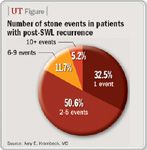Article
Stone recurrence, complications common after SWL
Just over half of SWL patients can expect at least one recurrence of stone disease and that recurrent stone disease is associated with new-onset diabetes mellitus.

One of the first retrospective studies on the long-term results of SWL was unveiled at the 2007 AUA annual meeting. First author Amy E. Krambeck, MD, a urology resident at the Mayo Clinic, Rochester, MN, told a moderated poster session that just over half of SWL patients can expect at least one recurrence of stone disease and that recurrent stone disease is associated with new-onset diabetes mellitus. But there appears to be no association between recurrent stone events and new-onset hypertension, and patients who already had diabetes at the time of SWL fared no worse than other patients.
"Those patients who had pre-existing diabetes mellitus were at no higher risk for recurrent stone events," said Dr. Krambeck, who worked on the study with Matthew T. Gettman, MD, and colleagues.
Researches found 578 patients from the original group who were still alive in 2004 and mailed questionnaires to them about their subsequent health status and any recurrent stone episodes following their original SWL treatment. Of those 578 patients, 288 (58.9%) responded and were included in the analysis.
Responses indicated recurrent stone disease in 53.5% (154) of the study group. Of the group with recurrent stones, 32.5% (50) reported a single recurrence, 50.6% reported two to five recurrences, 11.7% (18) reported six to nine recurrences, and 5.2% (eight) reported 10 or more recurrences.
Treatments for stone recurrence varied widely, Dr. Krambeck reported. Of the 154 patients with recurrent stone disease, subsequent SWL treatment was the most common option, reported by 58.4% (90) of the respondents. Other treatment choices included conservative treatment for 57.1% (88), ureteroscopy for 22.1% (34), percutaneous nephrolithotomy for 7.1% (11), and open nephrolithotomy for 2.6% (four). Because many patients had multiple recurrences, they may have received different treatments on different occasions, resulting in report totals exceeding 100%.
Chart reviews for the survey respondents found immediate postoperative complications following 13.9% of the original SWL treatments. Pain was the most common complication in eight patients (2.8%), followed by ureteral edema or obstruction and cardiac events in seven patients (2.4%). The next cluster of complications included sepsis and steinstrasse, both in six patients (2.1%), followed by fever and clot retention in two patients (0.7%). The least common complications included abscess, venous thrombosis, hypotension, and ureteral perforation in approximately one patient each.
Recurrence patterns noted
Several patient and treatment characteristics were associated with recurrent stone disease, Dr. Krambeck said. The most common associations included male gender (p=.004), younger age at original SWL treatment (p=.022), BMI >25 at the time of original SWL treatment (p=.007), the report of any complication associated with the original SWL treatment (p=.009), and treatment of a lower-pole stone during the original SWL (p=.025).
Chart review showed that 222 patients (78.5%) were originally referred to a nephrologist for treatment in 1985, but analysis of survey responses did not show any association with referral and stone recurrence. Survey responses also showed no association between pre-existing diabetes and recurrent stone disease or between recurrent stone disease and the development of new-onset hypertension or renal insufficiency, although stone recurrence was associated with the subsequent development of new-onset diabetes (p=.020).





